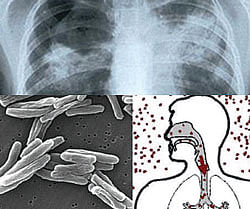The need to understand the human side of tuberculosis
With around 2 million cases annually, India has the highest burden of TB in the world. A communicable disease, TB spreads through the air and if left untreated, a person with active TB can infect 10-15 people every year.

Despite the fact that TB is curable, and the treatment is free it continues to be one of the leading causes of death in India — killing one person every two minutes and 750 people every day. Clearly, this makes TB, one of India’s greatest public health challenges.
Though anyone can contract TB, it flourishes in the most vulnerable, marginalised and discriminated populations. It disproportionately affects the poor leading to a loss of livelihood, creating a cycle of poverty. It is poverty that makes people vulnerable to TB and the way TB is addressed in India makes the poor, poorer.
A minimum of 3-4 months of work time, that equals 20–30 per cent of annual household income are lost to the battle against TB. For the poor, this is catastrophic. The direct and indirect costs of TB, in the case of India, stand at $23.7 billion annually. It is also the cause of extensive economic losses and individual, family and community suffering.
Moreover, the disease continues to be highly stigmatised, often leading to discrimination within both the community and the workplace.
TB especially affects children and women. It remains amongst the top ten diseases to kill children worldwide. Parents often have to leave their jobs to take care of children leading to loss of livelihood and treatment costs fuelling poverty. In India, every 5 minutes a child dies of TB. Despite this, there is limited attention paid to TB as a children’s health issue. A lack of political will, inadequate funding, and exclusion of children from research remain barriers to eliminating childhood TB.
Resistance to TB drugs in the form of Multi Drug Resistant TB (MDR-TB) and Extensively Drug Resistant TB (XDR-TB) have further complicated the TB landscape. The duration of treatment for MDR-TB lasts from 18 to 24 months and is extremely costly as compared to treating drug sensitive TB. To add to the woes, the medications for drug resistant TB have severe side effects leaving the patient’s life in jeopardy.
The recent disclosure of the emergence of the first set of Totally Drug Resistant TB (TDR-TB) cases in India is alarming. TDR-TB is the result of further mutation of the bacilli found to cause MDR and XDR TB. It has been reported that 12 TB patients have been found to have TDR-TB in one site – The Hinduja Hospital in Mumbai. The biggest challenge is treating TDR TB, as none of the known TB combination drugs work and sadly, at this stage the only step to assist patients is either surgery or medication with limited relief.
Uncontrolled sale of drugs
As the national programme struggles to cope with these issues, drug resistance is made worse by the uncontrolled sale of anti TB drugs and ineffective TB diagnostics. These are now a lucrative market built on great human costs. Patients in the private sector are subjected to serological (blood) tests that have poor sensitivity and specificity for TB diagnosis.
In 2011, the World Health Organisation called for a ban on the use of serological tests to diagnose active TB disease, declaring them inaccurate and a major risk to the health of patients. The continued use of these tests is a clear violation of the right to life and highlights the significant role of the private sector in TB control. The disease cannot be fought without appropriately involving the private sector. Due to unregularised and freely available anti TB drugs in the market the private sector, the drug resistance is continuously rising.
There is an urgent need to act especially for those whose disease status can be ignored, discriminated and exploited. Many of these stories remain untold. While we discuss the rising numbers of TB and the various challenges facing its prevention and control, a vital challenge that remains is the little or no understanding of patient perspectives. As half of India’s TB affected population seeks private healthcare, we know what the patients want in terms of diagnostic facilities and treatment. We do not know how to reach all of them.
The real story of TB is not in its numbers but in the human voices that are waiting to be heard. While there can be no single complete solution to India’s TB problem we need to start by listening to the voices of those affected - patients and communities. Ultimately, it is the patient who suffers the effect of TB and it is their families who deal with the poverty and death. Hence, public initiatives to educate and sensitise the patients, their families and society are important. There is an urgent need for social mobilisation and building consensus around the issue. The issue demands reaching out to key segment of policy makers, opinion leaders, religious groups, private sector and media amongst others, to make the voice of the sufferers heard.
The national TB programme needs to introspect why despite being a success, almost 50 per cent patients still seek treatment in the private sector and India’s TB burden continues to grow. Most importantly, private doctors that treat TB patients incorrectly and prescribe ineffective tests need to introspect, how they are risking hundreds of thousands of lives for personal greed.
Health and human rights are inextricably linked. TB causes loss of livelihood, stigma, social marginalisation morbidity and death. We need to understand its devastation comprehensively and act to address the challenges for TB control in India. Unless this is done, TB will be yet another disease that kills thousands and yet slips off the public imagination. Perhaps it’s time we heard its human story.
(The writer is a TB patient)